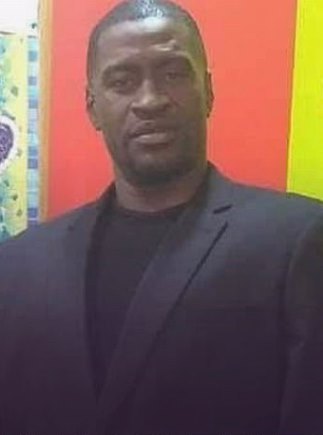
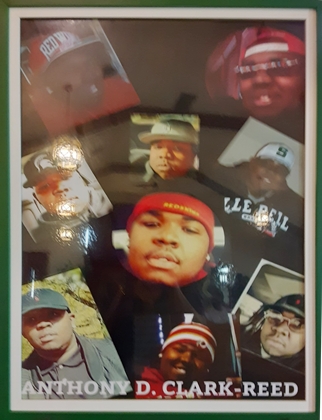
ANTHONY CLARK-REED, 24–Suffocated by Detroit police March 30, 2015; video: cops forced him out of car during asthma attack, sat on his back to handcuff him, delayed getting his inhaler, then illegally administered it themselves
Dr. Werner Spitz: Clark-Reed “died as a result of asphyxiation due to his inability to breathe brought on by asthma, triggered by stress, agitation and fear during his arrest.”
Cops first told Med. Examiner that Clark-Reed choked following swallowing drugs, ran those comments on WXYZ page; ME found no drugs in stomach
Detroit Police Chief Craig, Mayor Duggan told media police not responsible for Clark-Reed’s death, despite U.S. District Court ruling in favor of family
Craig, Duggan launch police attacks on peaceful marchers protesting murder of #GeorgeFloyd, claim Detroit cops different from all others
Terrance Kellom, 19, killed by Detroit police task force three weeks after Clark-Reed’s death; no charges brought in either death, many more
By Diane Bukowski
June 4, 2020
DETROIT– Millions of marchers flooded streets across the U.S. and globally, part of historic, unprecedented uprisings after Darnella Frazier’s chilling video of the murder of #GeorgeFloyd by Minneapolis police May 25 went viral. On May 28, family and friends of Anthony Clark-Reed, 24, similarly suffocated by Detroit police March 30, 2015, joined the rising tide to call for justice for George Floyd and for their loved one, and charges against all the police officers involved.

Neighborhood youth and friends of Anthony Clark-Reed at prayer vigil outside Springwells Ave. Baptist Church April 1, 2015.
“I’m tired, everybody’s tired because of these rogue cops out here doing whatever they want,” Clark-Reed’s mother Veda Reed said, weeping. “Why do we have to be scared every time we see a cop? They’re supposed to protect us, but they’re killing us –they’re killing us one by one.“
The press conference/rally was held at Springwells Avenue Baptist Church, a small venue ministering to an impoverished, multi-racial neighborhood on Detroit’s southwest side.
Pastor Kevin Clark, father of Anthony Clark-Reed, leads the church. He was joined by other leaders including Pastor Keyon Payton, EBONY Foundation’s National Director of Community and Outreach and Engagement and head of the New Bethel Missionary Baptist Church in Pontiac, and Pastor K.C. Pierce II of the Hopewell Missionary Baptist Church in Detroit.
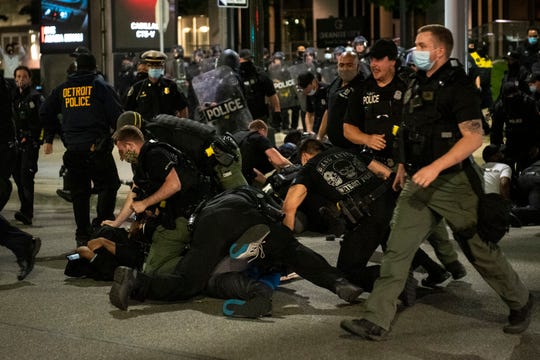
Detroit cops attack peaceful marchers May 29, the first day of protests in Detroit against the murder of George Floyd. Photo: Nic Antaya/DN
Despite the family’s recent victory in federal court detailed by Attorney Herb Sanders, Detroit Police Chief James Craig said in coverage of the event that the officers were not and will not be charged, and denied any liability for the young man’s death. Craig told Channel 7 that Clark Reed died from “asthma and morbid obesity,” and that police actions in his death were deemed appropriate by Internal Affairs and Wayne County Prosecutor Kym Worthy.
However, U.S. District Court Judge Linda Parker did not agree in her ruling on the Defendants’ Motion to Dismiss the case rendered Sept. 20, 2019. (See summary of key points in ruling in box below at left.)
Craig later condemned peaceful marchers in Detroit protesting the death of George Floyd, and launched police attacks on them beginning the first day of protests May 29. He, Mayor Mike Duggan, and “community leaders” they recruited claimed protesters were from outside the city, and that Detroit police are different from those across the country, not responsible for repeated cases of brutality like the murder of George Floyd. Craig said the FBI and the Department of Homeland Security were working with the DPD to investigate and stem the protests.
The Channel 7 report above reported in error that police got Clark-Reed out of his car to “save his life” from asthma attack; the stop precipitated it.
Clark-Reed died on Detroit’s impoverished southwest side at Vernor and Lawndale, around the corner from the small Springwells Avenue Baptist Church pastored by his father the Rev. Kevin Clark. U.S. District Court Judge Linda Parker allowed the family’s civil lawsuit in Clark-Reed’s death to move forward in a ruling Sept. 19, 2019, partially denying the city’s motion to dismiss it. See full ruling at http://voiceofdetroit.net/wp-content/uploads/AClarkReed-Lawsuit-Ruling.pdf.
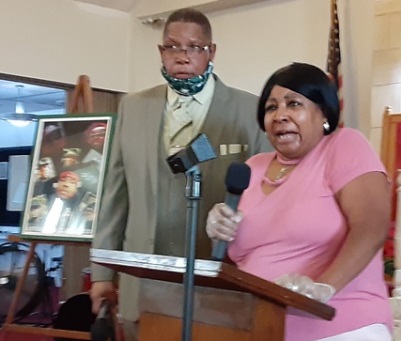
Pastor Kevin Clark and Veda Reed, parents of Anthony Clark-Reed, at rally May 28, 2020. “They are killing us one by one,” Reed said.
According to the lawsuit, Judge Parker’s summation of facts, and a store videotape, Detroit police officers Tracy Moreno, Robin Carver, and Eric Carthan pulled Clark-Reed’s burgundy Dodge Charger over because it had partially tinted windows.
The officers were part of a special unit looking for drugs, guns and gang activity in a targeted neighborhood. At the time, Chief Craig was conducting police sweeps across Detroit neighborhoods and massive roundups, looking for those with outstanding warrants. During the rally, Clark-Reed’s mother Leda Reed detailed ongoing police beatings and harassment of youth in Detroit.
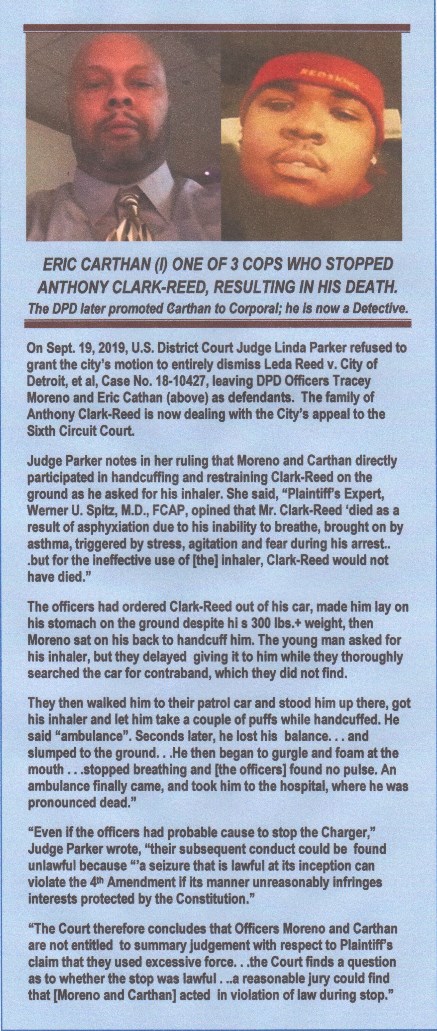 On the day of Clark Reed’s death, Moreno was driving the scout car. Clark-Reed complied with his orders to turn off his car, open all its windows, and place his hands behind his head. Moreno then opened the driver’s door, ordered Clark-Reed to exit and lay on the ground, then handcuffed him while sitting on his back. The young man man asked the officers to get his inhaler because he thought he was having an asthma attack.
On the day of Clark Reed’s death, Moreno was driving the scout car. Clark-Reed complied with his orders to turn off his car, open all its windows, and place his hands behind his head. Moreno then opened the driver’s door, ordered Clark-Reed to exit and lay on the ground, then handcuffed him while sitting on his back. The young man man asked the officers to get his inhaler because he thought he was having an asthma attack.
“I can’t breathe,” he told them.
But the officers stood him up and took him to the side of the squad car, as his breathing became “labored,” while they thoroughly searched his car, unsuccessfully, for contraband, opening all the doors and the trunk. They finally brought him his inhaler and ineffectively administered it themselves as he called for an ambulance. Family attorney Herb Sanders said nationally-known forensic examiner Dr. Werner Spitz’ said Clark-Reed died of “suffocation.” The Wayne County Medical Examiner reported police falsely told him Clark-Reed had swallowed drugs, but found none in his stomach.d
Pastor Clark recounted the agonizing days after he was belatedly informed of his son’s death by police.
“I live in Pontiac and made it down here as fast as I could drive,” Pastor Clark said. “There was no police presence at the hospital—only a chaplain who told us Anthony died from a heart attack. I called Detroit Police Homicide only to get an answer, ‘Oh the one that swallowed the dope.’ I said beg your pardon. When they finally pulled up the report hours later, it was on a minor vehicle violation form. It took Chief Craig two days to call me. I told him he had been doing a wonderful job, but that I knew he was going to try to assassinate my son’s character. Just like they have done with Michael Brown and George Floyd. For five years they thought we would be silent—but we decided to come together today to let the city of Detroit and Chief Craig know this is not right.”
Below: video of Atty. Herb Sanders remarks on Anthony Clark Reed’s death
Above: Pastor Clark says uprisings across the country in George Floyd’s death are appropriate because Blacks waiting for justice for decades.
“I’m tired, everybody’s tired because of these rogue cops out here doing whatever they want,” Leda Reed told the congregation as some wept. “Why do we have to be scared every time we see a cop? They’re supposed to protect us, but they’re killing us –they’re killing us one by one.”
Clark-Reed was her only son and oldest child.

Anthony Clark-Reed with mother Leda Reed.
“He wasn’t just my son, he was my best friend,” Reed told VOD for an earlier story. “He had a smile on every day, and was always doing something silly. He was my first-born. He never cried even when he was a baby. He worked in Wixom for four years, went to Henry Ford College, and had just been hired at Chrysler.”
Reed said her son, who was 6 feet, two inches, and over 300 lbs., often drove his girlfriend’s new red Charger, and was frequently stopped by police.
“He would always call me or his girlfriend on his cellphone right away and leave it on so we could hear what was happening, and he would always call me by 9 p.m. to let me know he was home.” But on the night of March 30, 2015, neither heard from Anthony.
Veda Reed: Police known by name in community for constant illegal stops, frame-ups and harassment of poor youth and those of color.
Below is the original video of George Floyd’s murder, taken by Darnella Frazier, who has faced threats along with accolades for recording this horrendous act. Her video has been excerpted in coverage around the world, but visceral reaction to the original appalling Facebook video, shown below by British media, is the real source of the world-wide rebellions against police killings and brutality.
Detroit Police Chief Craig’s characterization of Detroit as a city with a police force different from those in other cities has often been repeated like a mantra by local mainstream media. But a review of the DPD’s history shows otherwise.
DETROIT POLICE KILLINGS, ETC. DURING CRAIG’S TERM 2013-PRESENT
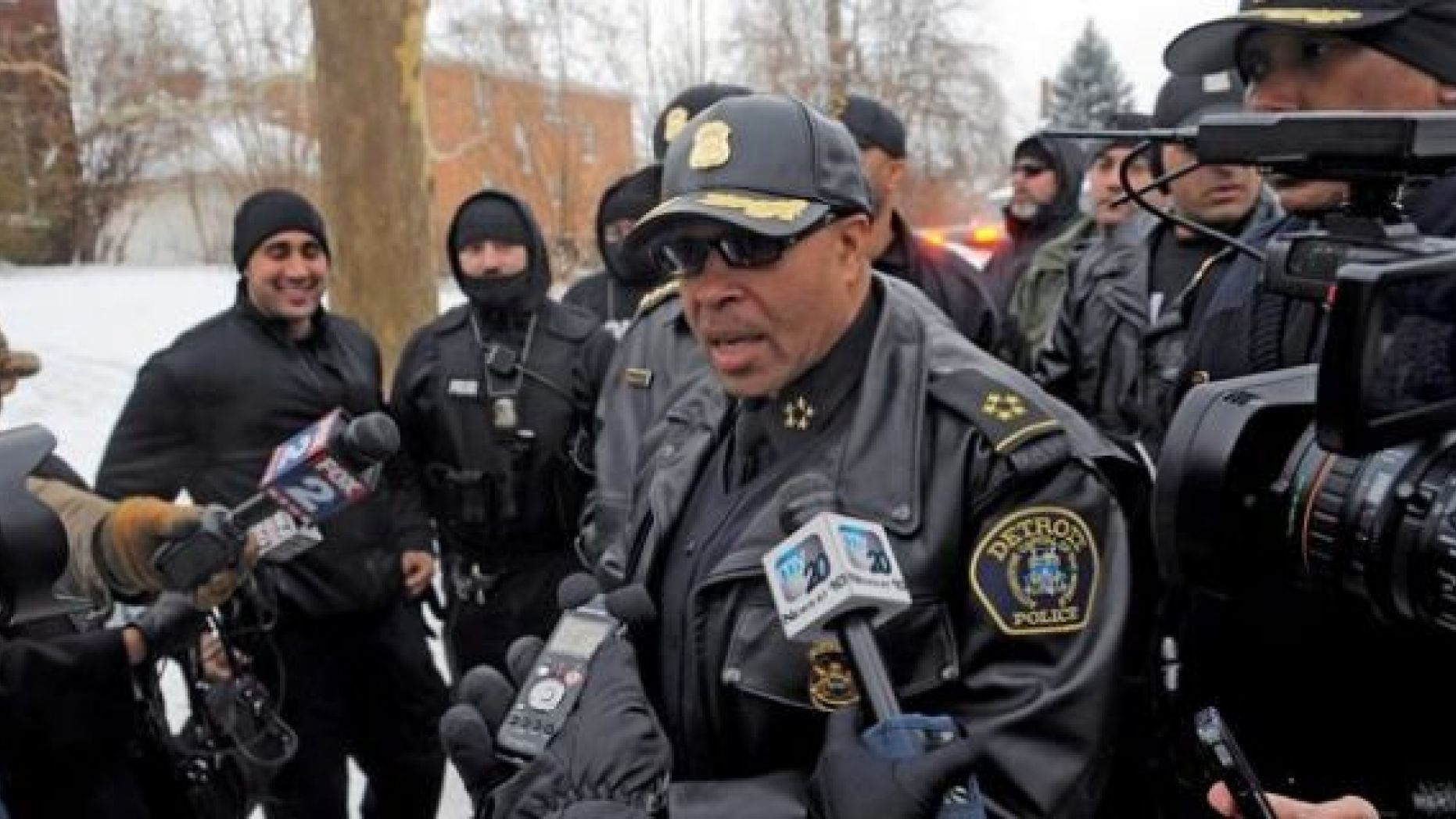
Chief Craig during Operation Mistletoe in Dec. 2013, one of many controversial massive police sweeps he ordered to find Detroiters with outstanding warrants. Hundreds were arrested as police from DPD, the ATF, Customs and more stormed homes and apartments occupied largely by poor Black families, without search warrants, as the corporate theft of Detroit’s assets proceeded with the largest urban bankruptcy in history. An article from Periphery Magazine on a Colony Arms Apts. resident’s reaction to the first raid is at http://www.theperipherymag.com/essay-a-residents-analysis
Chief Craig served with the Los Angeles Police Department for 27 years before Detroit’ Emergency Manager Kevyn Orr appointed him to his current post. During his tenure with the LAPD, he sat on its internal LAPD task force, which whitewashed the notorious Ramparts precinct cases involving killings, beatings, and frame-ups of dozens of city residents, most of them Black or Latinx. Later, the U.S. Department of Justice intervened and put the LAPD under a consent decree involving federal oversight.

Darren Reese-Brown (R), co-author of article on Colony Arms Apts. police raid, with his fiancee Cassandra and their four children (l to r)Cameron, Camari. Carissa, and Junior in 2014.
After he took office in Detroit, Craig launched massive police sweeps in neighborhoods throughout the city, allegedly targeting individuals with outstanding criminal warrants, but in fact attacking the poorest areas occupied by people of color, without search warrants, and armed to the teeth.
The raids were conducted by the Detroit Police Dept., the Bureau of Alcohol, Tobacco, Firearms and Explosives; the U.S. Drug Enforcement Administration; Michigan State Police; Border Patrol; Michigan’s Department of Corrections; and a unit of Detroit SWAT officers.
The illuminating reaction of Darren Reese-Brown about the first raid, at the Colony Arms Apartments on E. Jefferson, is disturbingly detailed in this story http://www.theperipherymag.com/essay-a-residents-analysis
Those raids were directly followed by police killings, including:

Matthew Joseph, 23.
April 2, 2013: MATTHEW JOSEPH, 23, killed by a multi-agency task force at the corner of Linwood and Hooker after a short chase. Detroit police officer Patrick Hill later died of wounds police admitted were “friendly fire,” first blaming Joseph.
Police alleged they were pursuing Joseph as a suspect in the killing of a crack dealer who was the son of a retired Detroit police officer. Another man in the car told VOD a lawyer for Joseph’s family said Joseph had been shot at least 50 times. Neighborhood witnesses contradicted police reports that he fired on them. They said Joseph died in the driver’s seat of his car without using his gun. (Craig launched Operation Mistletoe, shown in photo above, directly across the street from this location in Dec. 2013.)
AUGUST 26, 2013 Name withheld by police
An off-duty Detroit police officer fatally shot a suspected carjacker early Monday outside a Southfield apartment complex. The shooting happened around 2 a.m. at the Sutton Place Apartments in the 23000 block Riverside Dr., near 9 Mile Road and Lahser. Police say the officer was getting out of his Dodge Charger when he was approached by two armed suspects. “Fearing for his safety, he fired several rounds and struck one suspect,” said Southfield Lt. Nick Louissa. No known subsequent investigation.
NOVEMBER 28, 2014 SAMUEL TORRES
Police shot and killed Torres, saying they suspected him for murdering a woman earlier. Detroit police officers trailed the man to Macy’s Cleaners in Dearborn. Police say he pulled a gun on officers, who then shot and killed him inside the business.
APRIL 27, 2015 TERRANCE KELLOM, 19
Less than one month after Clark-Reed died, a Detroit “Fugitive Apprehension Task Force” invaded the home of Kevin Kellom without a warrant and assassinated his son, Terrance Kellom, 19 years old, giving rise to a massive march in their neighborhood near Joy Rd. and Evergreen.
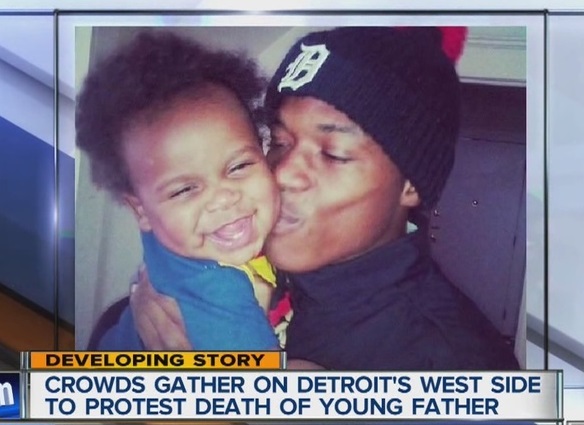
Terrance Kellom and infant son
Terrance had a six-month old son and was awaiting the birth of a daughter several weeks later.
Rallies for justice for #TerranceKellom continued across Detroit for months afterwards, as his family and supporters waited for Wayne County Prosecutor Kym Worthy’s decision on whether to bring charges.
Worthy sealed the autopsy report, a public record, and afterwards declared that federal I.C.E. officer Mitchell Quinn, who fired at least some of the bullets in a fusillade that killed Kellom, was not liable in Kellom’s death due to “insufficient evidence.” She upheld the DPD’s allegation that Kellom had threatened officers with a hammer, although no fingerprints were found on the hammer, shown in an evidence photo a substantial distance away from where Kellom fell.
But Detroit Police Officer Darell Fitzgerald, head of the DPD section of the task force, said in a sworn deposition Nov. 26, 2018 that the young father was in custody, unarmed, with no hammer in his hand, when he was killed, and that he buckled to his knees after the first shot before the rest of eight bullets struck him. He also said that he saw no hammer in the house.
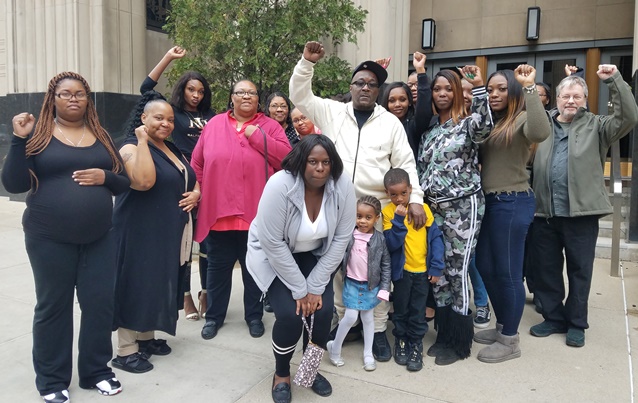
Terrance Kellom’s family and their supporters outside federal court May 2, 2019 after DPD officer Fitzgerald said Kellom had no hammer. Kellom’s children are standing in front with his father Kevin Kellom.
At trial however, Fitzgerald denied his sworn deposition statements, stating that he did not see Kellom at all after the shooting, The jury found against Kellom’s family. In January, 2020, the U.S. Sixth Circuit Court denied the family’s appeal, on grounds that “The Civil Appeal Statement of Parties and Issues and transcript Purchase Order entry were not filed as requested.” U.S. District Court Judge Sean Cox, known as an ultraconservative, earlier denied the impoverished family’s request for free copies of the trial transcripts.
The case is on record as Nelda Kellom v. Mitchell Quinn, Case No. : 2:17-cv-11084.
June 25, 2015: MAKIAH & MICHAELANGELO JACKSON, 3 & 6 YRS. OLD

Michaelangelo and Makiah Jackson, 6 and 3
Killed during reckless chase of driver Lorenzo Harris by Detroit Special Ops officers Steven Feltz, Richard Billingslea, and Hakeem Patterson. The cops claimed they saw him with a gun in his car, which was never found. They started chasing Harris near E. Warren and Haverhill, wound south almost to Mack Avenue, then back up Nottingham. The Jackson children were killed on Nottingham near Frankfort, north of E. Warren.
“The police tried to ram the car at the corner of Nottingham and Brunswick [one block north of Mack] and nearly hit my kids, 14 and 11,” a resident living near that location said. “He [Harris] almost jumped that curb over there where there were other little kids. You’d think the police would have backed off thechase at that point, but they were going 80 to 90 mph right on his bumper. If he would have tapped his brake, they would have hit him.”
Police in the reckless chase were never charged. Instead Harris was tried and convicted of second-degree murder.
DECEMBER 23, 2015: KEVIN MATTHEWS, 35

Kevin Matthews
Matthews, who suffered from mental illness but was nonviolent, was shot multiple times and killed by a white Dearborn cop, still unidentified by Wayne County Prosecutor Kym Worthy, never brought charges. The cop chased Matthews, who was on foot, in his police car on Tireman, the border between Detroit and Dearborn.
He then exited the car to chase him on foot out of range of his car’s dashcam video, to a backyard in Detroit, where he shot him multiple times as a neighbor heard him begging, “Don’t shoot.” His family said Matthews was on disability income, and had also been hit by a car Thanksgiving Day, breaking his arm and sustaining injuries to his head. They said his cast had just come off, but he still could not use his arm to pose a threat. The National Action Network of Detroit held a large march to protest his death in Dearborn Jan. 2, 2016, but has not followed up since.
JANUARY 27, 2016: JANET WILSON, 31

Janet Wilson

Janet Wilsons car, punctured by bullet holes, after it was rammed by cops.
Shot to death by Dearborn cops after they and Detroit cops followed her when she left Fairlane Mall in Dearborn after a verbal dispute with store employees.
Relatives said she was mentally ill and might have been off her medications. Police jammed her car into a roadblock. They claimed she had tried to run them down, then fired multiple rounds into her car, killing her. Charges were sought, by refused by Wayne County Prosecutor Kym Worthy. Her family later won $1.25 million in a lawsuit filed against the Dearborn officer and the City of Dearborn.
FEB. 2017 RAYNARD BURTON, 19

Raynard Burton

Cop Jerold Blanding
Detroit Police Officer Jerold Blanding, known in an Instagram Post as “Fatal Force,” chased 19-year-old Raynard Burton behind a house and shot him after an alleged struggle.
Officers said they pursued Burton because he’d been speeding. When Burton crashed and ran from his vehicle, Blanding left his partner behind to go after him on foot. Once out of view, Detroit police said the teen “lunged” at Blanding in an attempt to grab his gun, causing him to fire a single, deadly shot. This was the third time Blanding, a 22-year DPD veteran, had been involved in a shooting.
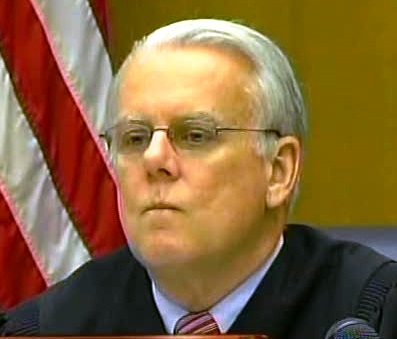
Judge Timothy Kenny

Thelonious ‘Shawn” Searcy
Blanding was never charged in Burton’s killing, but later that year was charged with 17 offenses involving driving and possessing three guns while intoxicated, and resisting and obstructing police officers. Wayne County Circuit Court Judge Timothy Kenny, now Chief Judge, dismissed all charges but a single one of resisting and obstructing, for which he sentenced him to two years of probation.
Last year, Kenny denied Thelonious “Shawn” Searcy’s motion for relief from judgment in a 2004 first degree-murder case. This was AFTER an evidentiary hearing in which Vincent Smothers confessed in detail to the murder, and during which it was proven that the decedent was killed by .40 caliber bullets, not .45 caliber bullets which Kenny falsely blamed in his opinion. Smothers, testifying without his attorney present, said he used a 40-caliber gun to kill the decedent in an account that matched forensic evidence.
During the trial in 2004, Kenny LIED to jurors, telling them that the bullets found in the decedent were “not identifiable.” Searcy has now served over 16 years in prison for a crime he did not commit, and recently tested positive for COVID-19.
JUNE 5, 2017 — Name withheld by police
An off-duty Detroit police officer was buying liquor when a man allegedly tried to rob him. Each shot, the man was killed, and the deputy wounded. Allegedly, someone came along shortly afterward and stole both their guns. No known charges.
SEPTEMBER 14, 2018 — ABDULLAH BEARD (DETRIC DRIVER)

Abdullah Beard (Detric Driver) with wife
Detric Driver, whose Muslim name was Abdullah Beard, was shot to death after Detroit police invaded his home in a no-knock raid, allegedly in connection with the earlier killing of a 5-year-old girl. He was not involved in that killing, however. He was sleeping on his living room couch when police broke in.
Police claimed there was a gun on the floor near Beard and that he pointed it at them. It was a gun the family legally used for protection in their poor neighborhood.
Later, the Michigan State Police initiated an investigation, after Beard’s political affiliations were exposed.

Imam Luqman Abdullah
#DullahBeard was a follower of Imam Luqman Abdullah, leader of a mosque in Detroit’s Black community in a poor west side neighborhood. Imam Abdullah was assassinated in 2009 during a sting operation by the FBI, and police from Detroit and Dearborn. He was shot 21 times after he defended himself from a police dog which had been let loose to bite him.
#DullahBeard was among the Masjif El-Haqq mosque members the FBI indicted on trumped-up charges, based largely on hearsay accounts by confidential informants who had infiltrated the group. The indictment cited alleged conversations with mosque members, not actual criminal activities.

Imam Jamil Al-Amin
The FBI investigation was linked to the group’s ties with Imam Jamil Al-Amin (formerly H.Rap Brown of the Black Panthers), both of them peaceful organizers of Black youth and families in their poverty-stricken communities. Imam Jamil El-Amin was framed for the murder of a Fulton County Deputy Sheriff who raided his home with others. Al-Amin is serving a life sentence in federal prison.
Similar FBI stings were conducted against groups of Black men in Florida and New York during the same time period.
The targeting of these Black Liberation activists brings to mind the announced involvement of the FBI in identifying so-called “violent” protesters participating in the massive marchers across the U.S. decrying the murder of George Floyd.
See FBI release at: https://www.fbi.gov/news/pressrel/press-releases/seeking-information-on-individuals-inciting-violence-during-first-amendment-protected-peaceful-demonstrations
JUNE 3, 2019 KEVIN PUDLIK, 41

Kevin Pudlik
Kevin Pudlik, 41 and paralyzed, was the passenger in a car driven by another man who led Detroit and Michigan State police on a high-speed chase on Detroit’s southwest side. Police brought the car to a stop by ramming it at least three times in a so-called “pit maneuver,” then opened up with a barrage of gunfire from the driver’s side of the car.
The driver was hit twice and survived, but Pudlik, who could not play any role due to his paralysis, was shot multiple times by gunfire entering the driver’s side and proceeding to the passenger side.
DECEMBER 16, 2019 LOUIS PATRICK VEAL
Detroit police shot Louis Veal to death. It happened around 4:40 p.m. on Woodlawn near Erwin. The officers were conducting an investigation of an earlier double murder when an unknown person (identity later revealed) fired shots at them. The officers returned fire, striking and killing the suspect.
JANUARY 18, 2020 MAURICE JOHNSON, 40
Maurice Johnson, a 40-year-0ld father, was walking home from work at an oil-change shop along Telegraph Rd. when he was struck by a car driven by a man fleeing police. One officer had shot him in the the stomach earlier at a gas station on 7 Mile Rd. The man had allegedly stolen a car. He was shot in the stomach while sitting INSIDE his car. His car is seen in video with the driver’s side window smashed out. Normal DPD policy is to charge the driver being chased, not the police who conducted the reckless chase.
FEBRUARY 24, 2020 KENYEL WILLIAM BROWN, 40
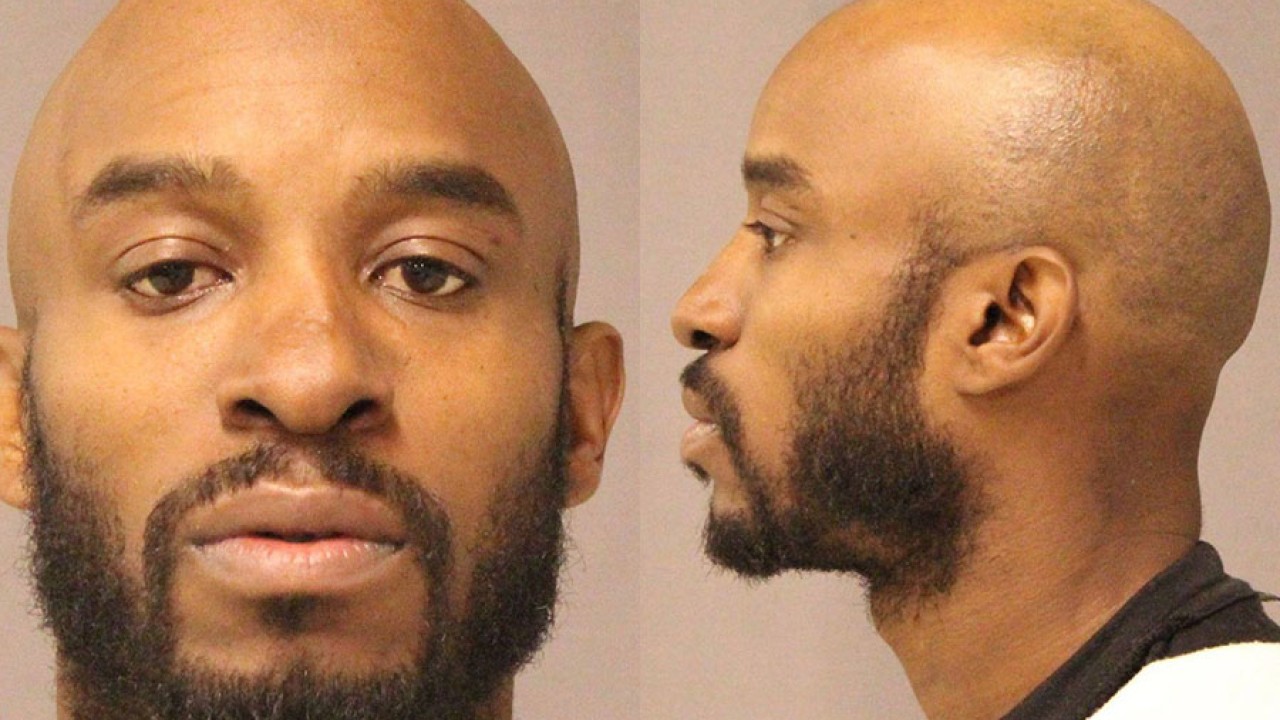
Kenyel Brown
Kenyel William Brown was a suspect in six fatal shootings in the metro area, and allegedly on the run.
He was never tried or convicted for any of the shootings, and was later exposed as a police informant.
Police from Detroit and suburban police chased him to the backyard of a home in Oak Park, a predominantly Black suburb north of Detroit. As seen in the video above, whatever happened in that backyard was screened from view by a solid white wooden fence with a height exceeding that of most people. Although police helicopters were at the scene, no video was published from their vantage point. Detroit police claimed Brown shot himself in the head while inside that backyard, and later died from his injuries at a hospital.
BELOW: PROTESTS AGAINST THE DEATH OF GEORGE FLOYD, POLICE BRUTALITY AND RACISM CONTINUE DAILY IN METRO DETROIT AND CITIES ACROSS THE U.S. AND THE WORLD. VIDEO BELOW IS JUNE 6. One protester’s sign shown at the end of this video demands “De-fund Police.” That demand is spreading nationally.
THE BATTLE CONTINUES IN METRO DETROIT SUNDAY, JUNE 7, 2020 CALLING FOR END TO POLICE KILLINGS, BRUTALITY:
- Rochester Hills, 10 am, Rochester Hills public library
- Grosse Ile, 10 am, Corner of Macomb and Meridian
- Novi, 11 am, Novi Police Headquarters
- Madison Heights, 12 pm, Madison Heights City Hall
- Bloomfield Hills, 12 pm, City of Bloomfield Hills, MI – City Hall
- Romulus, 12 p.m. Corey Elementary parking lot
- Southfield, 12 p.m., Hope United Methodist Church
- Oak Park, 1 pm, corner of Coolidge and 9 Mile Road
- Detroit, 1:15 pm, Dequindre Cut
- Royal Oak, 2 pm, 211 S Williams St
- Ypsilanti, 2 pm, Ypsilanti District Library
- Waterford, 4 pm, Waterford Police Department
- Ferndale, 4 pm, Ferndale Police Department
- Detroit, 4 pm, Detroit Police Headquarters
- Sterling Heights, 4:30 pm Hall Rd near the Golden Corridor
#BlackLivesMatter, #GeorgeFloyd, #AhmaudArbery, #BreonnaTaylor, #EricGarner, #MichaelBrown, #SandraBland, #BlackLivesMatterDetroit, #Justice4AnthonyClarkReed, #Justice4TerranceKellom, #Justice4JanetWilson, #Justice4KevinMatthews, #Justice4AbdullahBeard, #Justice4RaynardBurton, #Justice4MariahMichaelangeloJackson, #Justice4ImamLuqmanAbdullah, #Justice4KevinPudlik, #Justice4LouisVeal, #Justice4MauriceJohnson, #Justice4KenyelBrown, #Jailkillercops, #Beatbackthebullies, #PoliceState,#PrisonNation, StopPoliceBrutality, #StopWaronBlackAmerica, #DeFundPolice
************************************************************************************
 Donations for the Voice of Detroit are urgently needed to keep this paper going. It is published pro bono, by individuals on limited incomes or none at all (MDOC prisoners). Among ongoing expenses are quarterly HostLab web charges of $360, costs for court documents, internet fees, office supplies, gas, etc. Please, if you can:
Donations for the Voice of Detroit are urgently needed to keep this paper going. It is published pro bono, by individuals on limited incomes or none at all (MDOC prisoners). Among ongoing expenses are quarterly HostLab web charges of $360, costs for court documents, internet fees, office supplies, gas, etc. Please, if you can:
DONATE TO VOD at
https://www.gofundme.com/VOD-readers-up
************************************************************************************
Colony Arms Apts. resident Darren Reese-Brown’s article on Detroit police task force raid on his apartment building in 2013:
http://www.theperipherymag.com/essay-a-residents-analysis
RELATED STORIES FROM VOICE OF DETROIT:
Related stories on Terrance Kellom:
KELLOM FAMILY PACKS COURT AFTER COP’S ADMISSION THAT DETROIT DAD WAS UNARMED WHEN ‘EXECUTED’
voiceofdetroit.net/2013/04/29/police-slaughtered-matthew-joseph-23-on-detroit-streets/
DETROIT POLICE SWAT TEAM KILLS MAN ASLEEP IN HOME, NOT SUSPECT IN EARLIER KILLING OF 5-YR.-OLD
http://voiceofdetroit.net/2010/10/04/cox-exonerates-fbi-in-imam-luqman-abdullah’s-murder/
Real Reasons for Imam Luqman Abdullah’s Assassination http://voiceofdetroit.net/2010/10/30/1951/



 Shelton was convicted by an all-white jury in the first case of three counts of first-degree criminal sexual conduct and sentenced to 40-60 years in prison, and of rape and assault in the second case, for which he was sentenced to 1 to 4 years and 2 years. The second offense allegedly took place two weeks after the first, both in February, 1993.
Shelton was convicted by an all-white jury in the first case of three counts of first-degree criminal sexual conduct and sentenced to 40-60 years in prison, and of rape and assault in the second case, for which he was sentenced to 1 to 4 years and 2 years. The second offense allegedly took place two weeks after the first, both in February, 1993.
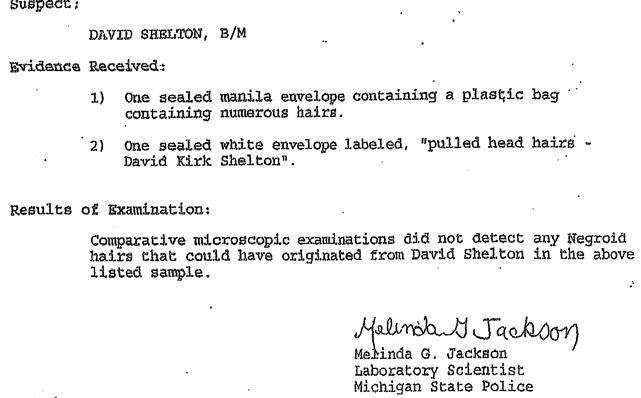

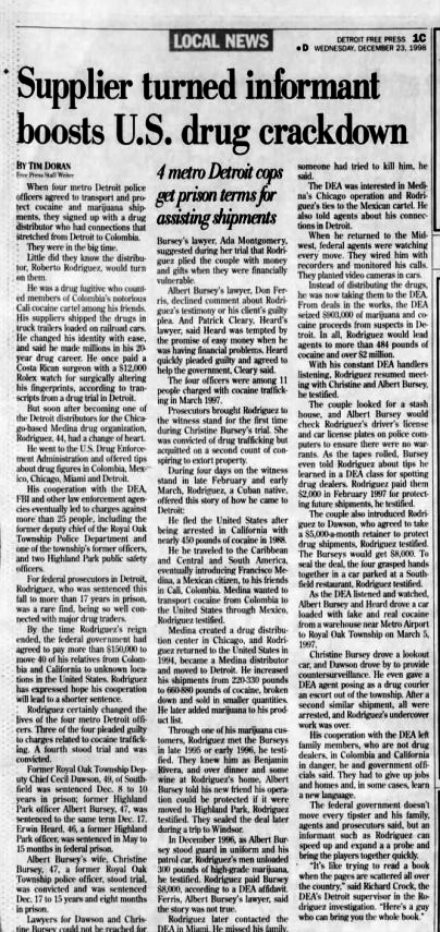
 “Experts say a 35 percent acquittal rate is a sign prosecutors are bringing cases that don’t hold up under a jury’s scrutiny,” the Free Press said. “‘That’s high and that should give them concern,’ said Abbe Smith, the former deputy director of the Criminal Justice Institute at Harvard University. ‘The charging decision is a critical decision. You should not prosecute every case.” (See text version of complete article below story.)
“Experts say a 35 percent acquittal rate is a sign prosecutors are bringing cases that don’t hold up under a jury’s scrutiny,” the Free Press said. “‘That’s high and that should give them concern,’ said Abbe Smith, the former deputy director of the Criminal Justice Institute at Harvard University. ‘The charging decision is a critical decision. You should not prosecute every case.” (See text version of complete article below story.)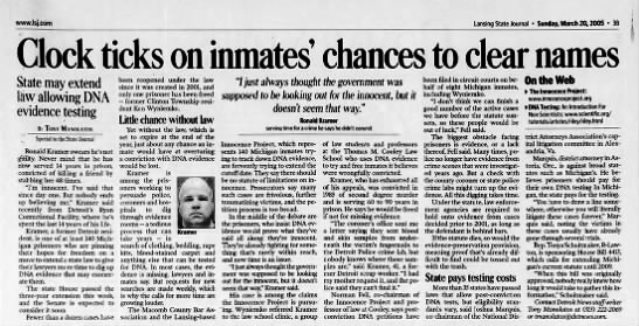 See text of complete article above at:
See text of complete article above at: 


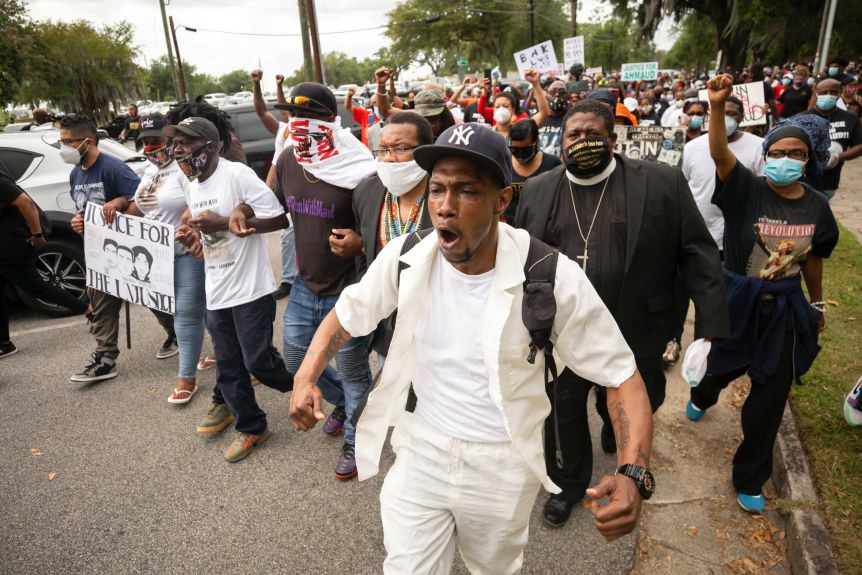


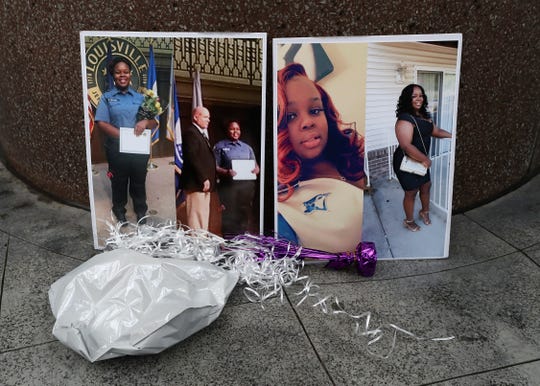

 By JASON DEAREN and MIKE STOBBE, Associated Press
By JASON DEAREN and MIKE STOBBE, Associated Press 

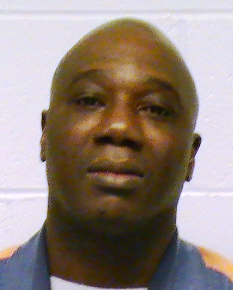


 “I returned on the third day of Carl Hubbard’s trial after spending two days at the 1300 Precinct where I was threatened by Homicide officers Sergeant [Joann] Kinney and Sergeant [Ronald] Gale with being charged with the murder of Mr. Penn if I didn’t say that I saw Carl Hubbard at the murder scene of Mr. Penn. This is why I testified in the manner I did on the third day of Carl Hubbard’s trial, because of the fear I had of Sergeant Kinney and Gale’s threats of charging and prosecuting me for a crime that I had no knowledge of.”
“I returned on the third day of Carl Hubbard’s trial after spending two days at the 1300 Precinct where I was threatened by Homicide officers Sergeant [Joann] Kinney and Sergeant [Ronald] Gale with being charged with the murder of Mr. Penn if I didn’t say that I saw Carl Hubbard at the murder scene of Mr. Penn. This is why I testified in the manner I did on the third day of Carl Hubbard’s trial, because of the fear I had of Sergeant Kinney and Gale’s threats of charging and prosecuting me for a crime that I had no knowledge of.”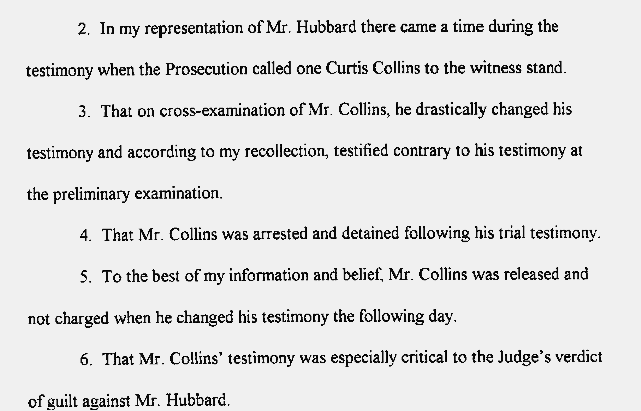

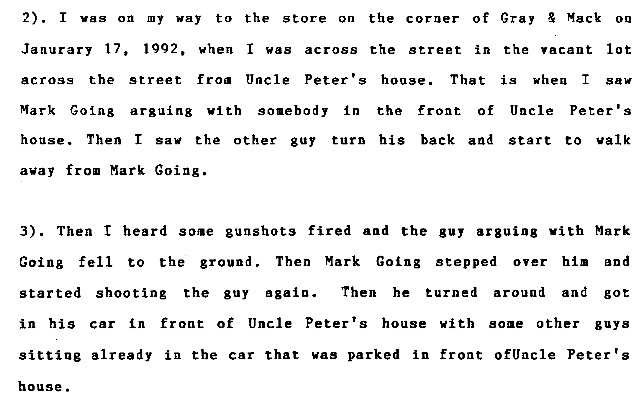
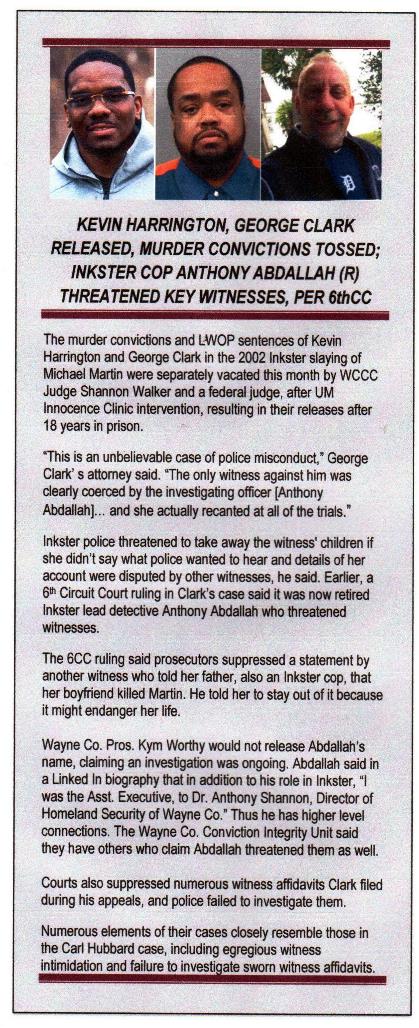
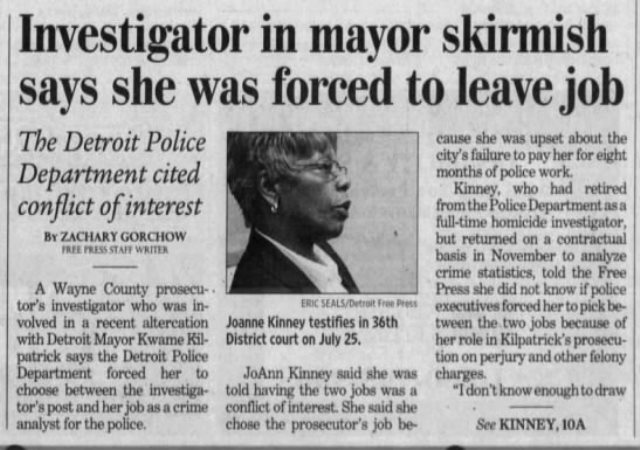

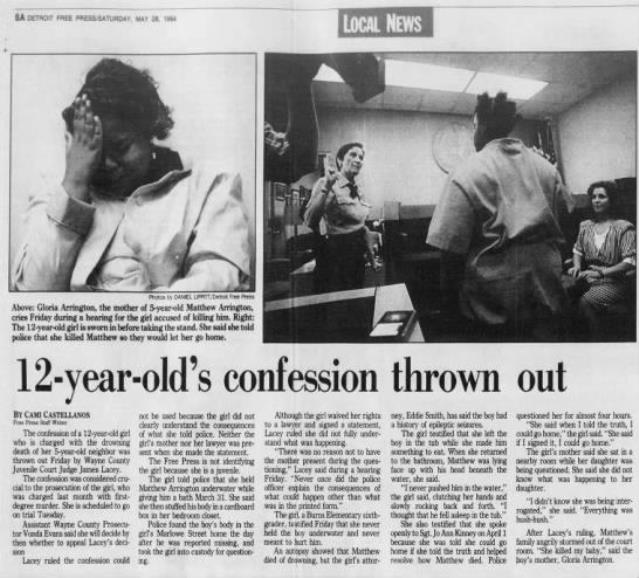


 Those practices began many decades ago when the “Big Four” DPD cars roamed the city, singling out young Blacks for arrest, to the 1967 rebellion, when dozens of poor, largely Black people were murdered by police and the National Guard, to STRESS (Stop the Robberies, Enjoy Safe Streets), whose undercover cops slaughtered Black men at random, and continuing to the present day.
Those practices began many decades ago when the “Big Four” DPD cars roamed the city, singling out young Blacks for arrest, to the 1967 rebellion, when dozens of poor, largely Black people were murdered by police and the National Guard, to STRESS (Stop the Robberies, Enjoy Safe Streets), whose undercover cops slaughtered Black men at random, and continuing to the present day. 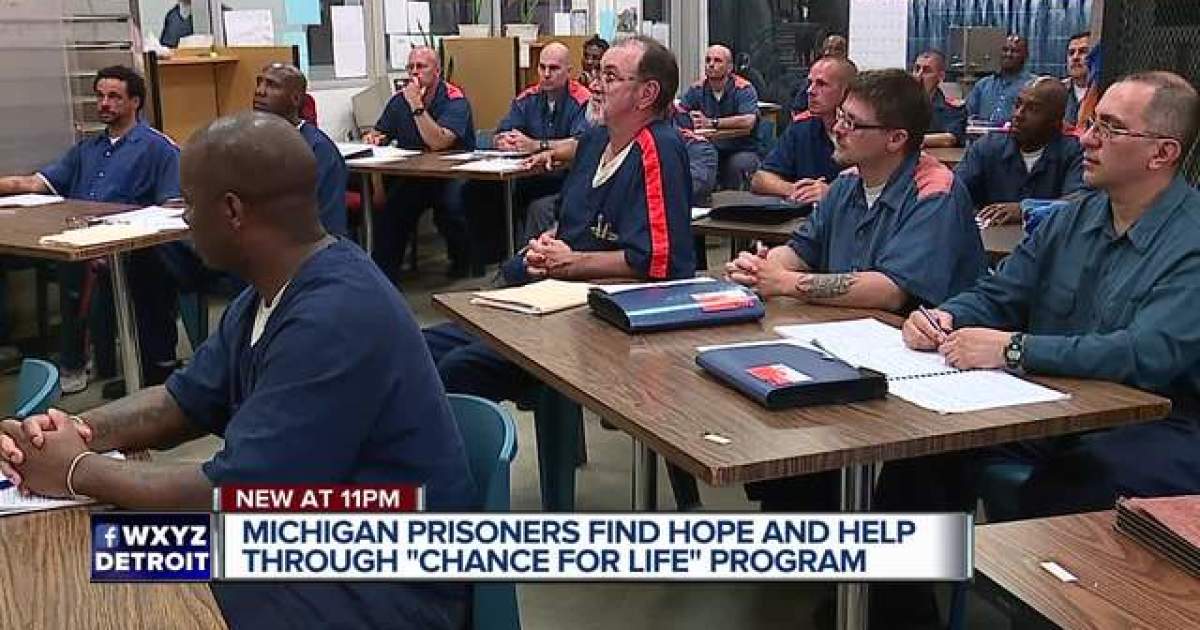



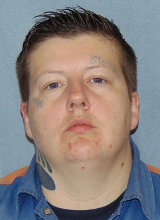

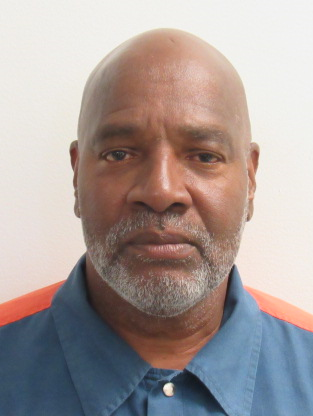






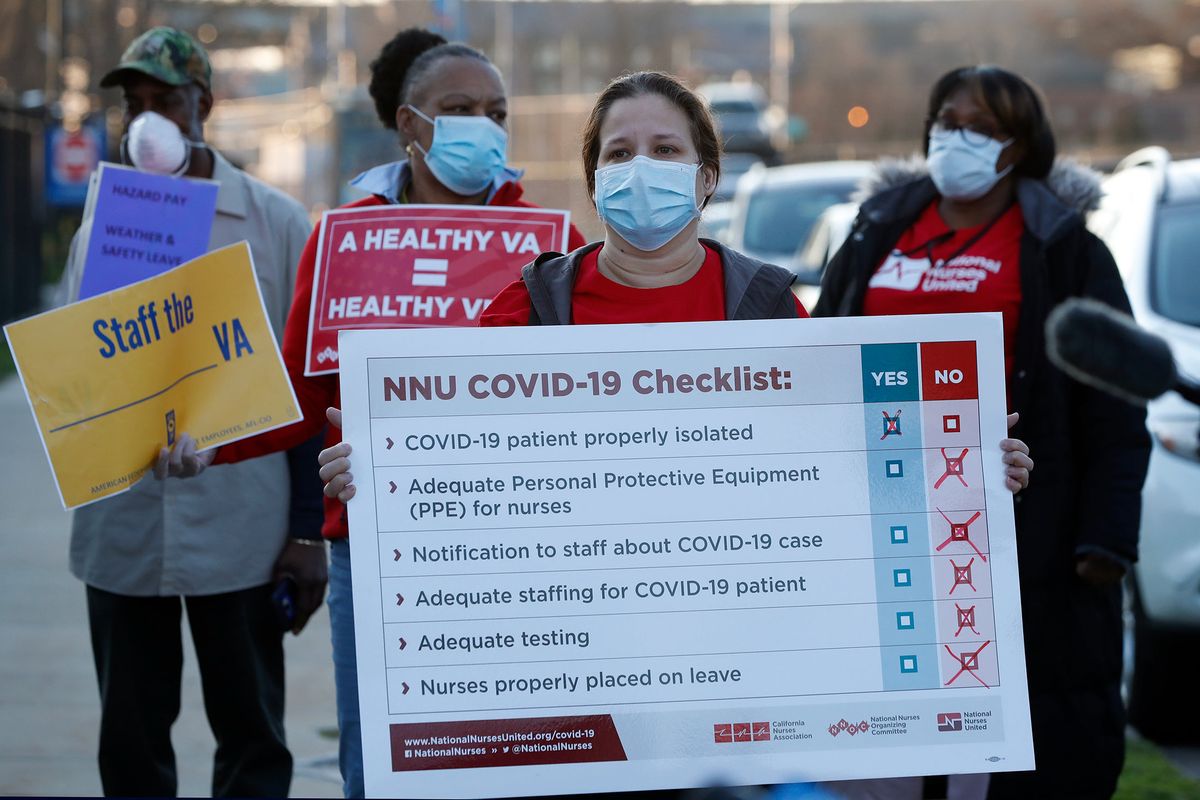

 When two incarcerated men who tested negative approached a staff supervisor asking why the 12 would be moved to a positive unit if they hadn’t tested positive a staff member responded, “It’s a numbers game. I know these 58 guys are negative so I’m going to protect them. I don’t know what’s going on with the other 12 guys. I just have to sacrifice them for the greater good.”
When two incarcerated men who tested negative approached a staff supervisor asking why the 12 would be moved to a positive unit if they hadn’t tested positive a staff member responded, “It’s a numbers game. I know these 58 guys are negative so I’m going to protect them. I don’t know what’s going on with the other 12 guys. I just have to sacrifice them for the greater good.” I have also learned there are several men whose COVID-19 tests returned from the lab inconclusive. Those people were dispersed throughout the prison in various housing units as well for a couple days before staff discovered the error and placed them in a separate housing unit and retested them. They will reportedly remain there until the outcome of their test results.
I have also learned there are several men whose COVID-19 tests returned from the lab inconclusive. Those people were dispersed throughout the prison in various housing units as well for a couple days before staff discovered the error and placed them in a separate housing unit and retested them. They will reportedly remain there until the outcome of their test results.
 Sunday morning when men asked an LCF administrator why they hadn’t received any of the three therapeutics mentioned above they were told, “I don’t know, I don’t work for Health Care.” As he began walking away he remarked, “If you have anymore questions let me know, I’ll be around this week.”
Sunday morning when men asked an LCF administrator why they hadn’t received any of the three therapeutics mentioned above they were told, “I don’t know, I don’t work for Health Care.” As he began walking away he remarked, “If you have anymore questions let me know, I’ll be around this week.”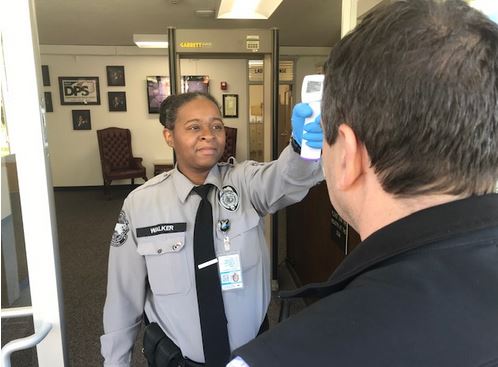
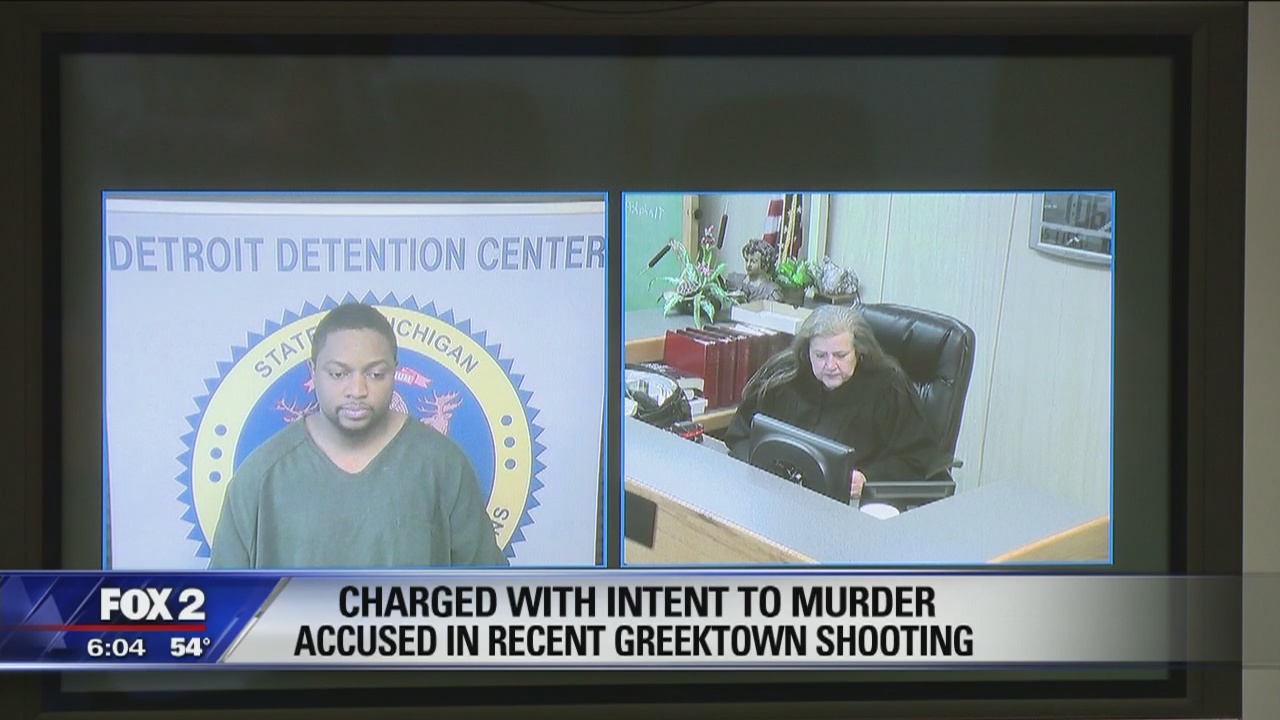
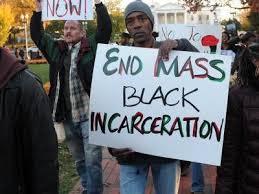
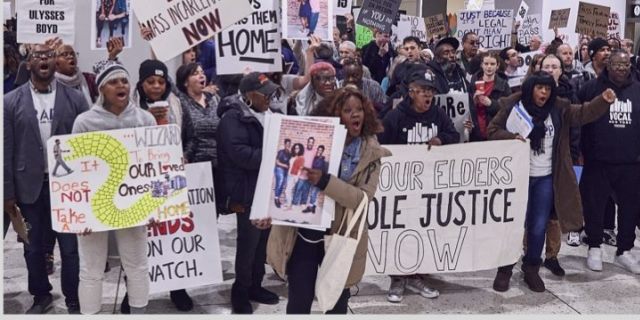
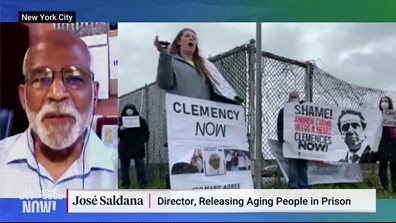 The same rings true in other states besides New York, who actually have the death penalty. The death penalty has long been abolished in Michigan since 1847. However, a life sentence basically equates to death by incarceration. Meaning, the Michigan Parole Board’s practice of the ‘Life Means Life’ policy, even if its a parolable life sentence, places all lifers in the same category.
The same rings true in other states besides New York, who actually have the death penalty. The death penalty has long been abolished in Michigan since 1847. However, a life sentence basically equates to death by incarceration. Meaning, the Michigan Parole Board’s practice of the ‘Life Means Life’ policy, even if its a parolable life sentence, places all lifers in the same category.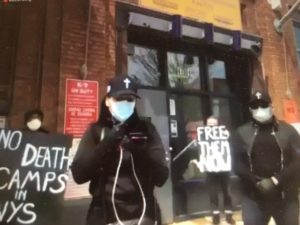

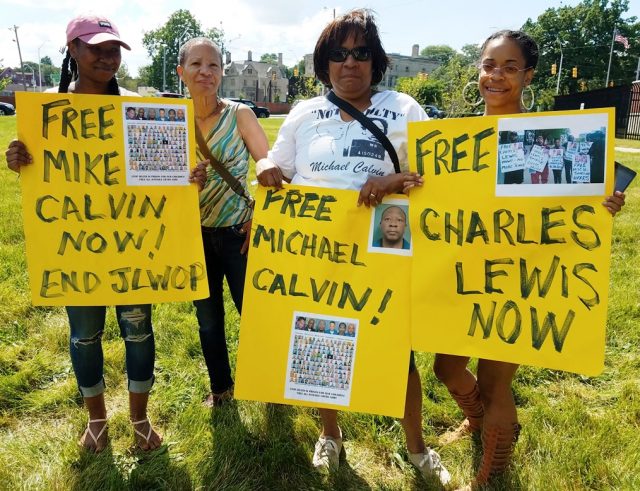




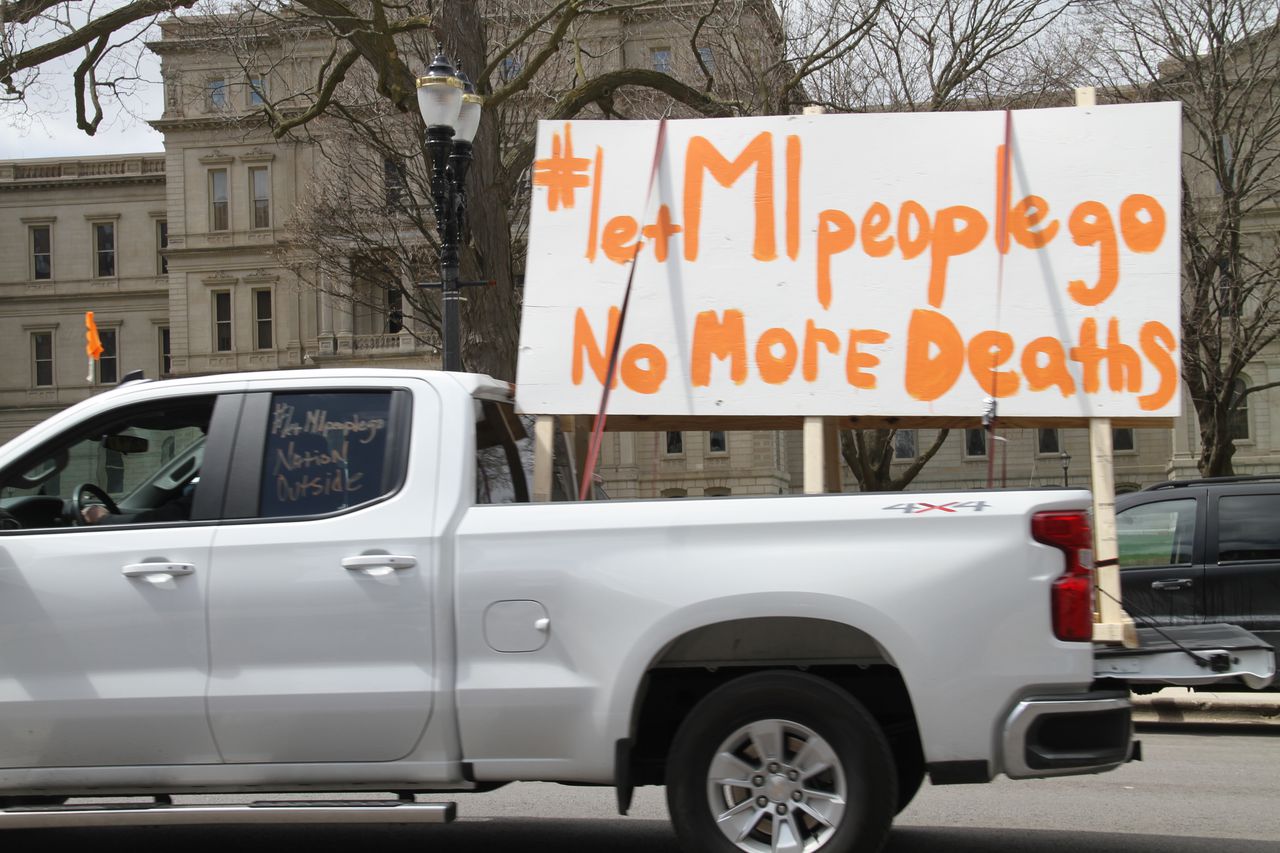









 With potentially hundreds of people at the prison infected with COVID-19 the number of people being hospitalized for urgent care is expected to continue surging. So is the number of people who succumb to COVID-19.
With potentially hundreds of people at the prison infected with COVID-19 the number of people being hospitalized for urgent care is expected to continue surging. So is the number of people who succumb to COVID-19. “We have to ensure that we never return to the society that enabled this pandemic to emerge.”
“We have to ensure that we never return to the society that enabled this pandemic to emerge.” Glen Ford, BAR Executive Editor
Glen Ford, BAR Executive Editor


 Cooperation Jackson, the Mississippi-based “emerging vehicle for sustainable community development, economic democracy, and community ownership,” last week put out a call for a general strike to begin on May 1st — May Day — and a list of demands “that will transform our broken and inequitable society, and build a new society run by and for us – the working-class, poor, oppressed majority.” (See
Cooperation Jackson, the Mississippi-based “emerging vehicle for sustainable community development, economic democracy, and community ownership,” last week put out a call for a general strike to begin on May 1st — May Day — and a list of demands “that will transform our broken and inequitable society, and build a new society run by and for us – the working-class, poor, oppressed majority.” (See 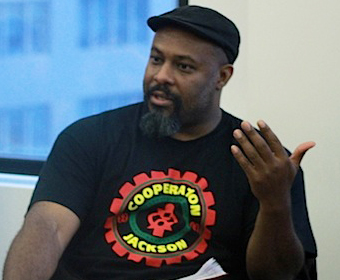



 BAR executive editor Glen Ford can be contacted at Glen.Ford@BlackAgendaReport.com .
BAR executive editor Glen Ford can be contacted at Glen.Ford@BlackAgendaReport.com .
